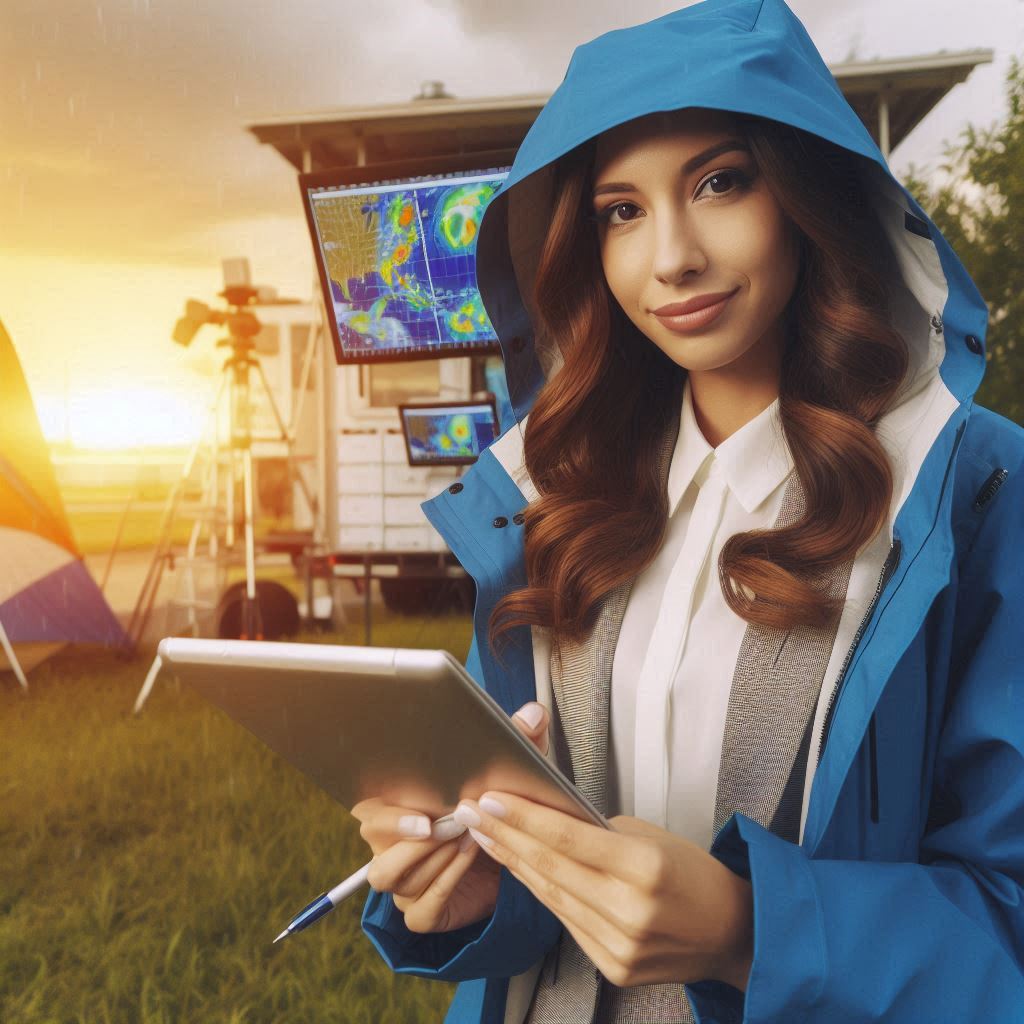Introduction
Public speaking is crucial for broadcast meteorologists.
They must communicate complex weather information clearly and engagingly.
Effective communication helps viewers understand forecasts and make informed decisions.
Meteorologists face unique challenges when delivering weather updates.
They must explain intricate data while keeping the audience engaged.
The unpredictability of weather events can create additional pressure.
Communicating urgent information during severe weather requires confidence and clarity.
Moreover, technical difficulties can disrupt broadcasts, challenging their ability to deliver timely updates.
A meteorologist‘s demeanor can significantly impact viewer trust and comprehension.
Therefore, honing public speaking skills is essential for success in this field.
This blog post provides essential tips for improving public speaking abilities.
First, we will discuss understanding your audience and tailoring your message.
Next, we will cover clear and concise communication techniques.
After that, we will explore how to utilize visual aids effectively.
We will also examine the importance of being engaging and dynamic during presentations.
Finally, we will emphasize the need for ad-libbing skills and seeking feedback.
By implementing these tips, meteorologists can enhance their communication skills and connect with their audience more effectively.
Know Your Audience
Understanding your audience is crucial for effective public speaking, especially as a broadcast meteorologist.
Start by analyzing the demographics of your viewers.
Consider their age, education level, and interests.
This knowledge helps you tailor your language and message effectively.
Understand the demographics of the audience you are speaking to
Using technical jargon may alienate some viewers.
Instead, aim for clarity and simplicity in your explanations.
Speak in everyday language that everyone can grasp.
For example, instead of saying “cumulonimbus,” say “storm clouds.”
This approach makes your content more relatable and easier to digest.
Tailor your language and message to be easily understood by a wide range of viewers
Incorporate relatable examples into your presentations.
Everyone has experienced different types of weather, from sunny days to heavy rain.
Use these shared experiences to connect with your audience.
For instance, when discussing a heatwave, mention how it affects outdoor activities like picnics or sports events.
This strategy makes your information more relevant to viewers’ lives.
Use relatable examples and analogies to make complex weather concepts more accessible
Analogies also enhance understanding.
They provide familiar comparisons that simplify complex weather concepts.
For example, compare a hurricane to a spinning top.
Explain how the top wobbles and eventually falls over, just like a hurricane’s path can change suddenly.
Such analogies help viewers visualize and grasp difficult ideas.
When discussing forecasts, frame your message in a way that resonates with your audience.
Highlight how weather impacts their daily routines.
Discuss how a snowstorm affects commutes or how rain can influence weekend plans.
This connection keeps viewers engaged and interested in your report.
Always remember to consider cultural differences.
People from different backgrounds may interpret weather information differently.
Be sensitive to these variations.
Adjust your examples and references to be inclusive and respectful.
This awareness fosters a sense of connection with your audience.
Use visuals to reinforce your message.
Charts, graphs, and images can help clarify complex data.
When explaining severe weather alerts, show maps that highlight affected areas.
This visual aid makes your message more impactful and easier to understand.
Engage with your audience during your presentation.
Encourage them to ask questions or share their experiences.
This interaction creates a dialogue that enriches the viewing experience.
It also allows you to address specific concerns or confusion directly.
Finally, practice your delivery.
Rehearse your presentation while considering your audience’s perspective.
This preparation ensures your language and examples resonate.
Tailoring your message to fit your audience is vital for successful public speaking.
By understanding your audience, you build trust and credibility.
When viewers feel understood, they are more likely to connect with your message.
Ultimately, this connection leads to better communication and a more informed public.
Practice Clear and Concise Communication
Effective communication is essential for broadcast meteorologists.
Viewers rely on you to deliver accurate weather information.
Practicing clear and concise communication enhances their understanding and engagement.
Avoid using technical jargon that may confuse viewers
Technical jargon can alienate your audience.
Terms like ‘stratosphere‘ or ‘cyclogenesis‘ may confuse many viewers.
Instead, use simple language that everyone can understand.
Describe weather events using relatable terms.
For instance, say ‘rain clouds‘ instead of ‘nimbostratus clouds.‘
This approach makes your message more accessible to a broader audience.
Use everyday language to explain weather phenomena in a concise manner
Conciseness is key when delivering weather updates.
Focus on delivering essential information without unnecessary details.
Viewers appreciate brevity in fast-paced news segments.
Use straightforward explanations to describe weather phenomena.
For example, explain thunderstorms as ‘storms with heavy rain and lightning.‘
This clarity helps viewers quickly grasp important concepts.
Another effective strategy is to break down complex ideas into smaller parts.
When discussing a weather system, explain its components.
Describe the front, pressure systems, and temperature changes separately.
This breakdown makes it easier for viewers to understand the bigger picture.
Incorporate relevant visuals to reinforce your message.
Weather maps, charts, and graphics can clarify your explanations.
Use these visuals to illustrate important points.
For example, highlight areas affected by severe weather on a map.
Visuals can enhance comprehension and keep viewers engaged.
Practice your delivery regularly.
Rehearse your presentations to improve your confidence and clarity.
Pay attention to your pacing and tone.
Speaking slowly allows viewers to absorb information.
A calm and steady voice promotes understanding, especially during stressful weather updates.
Practice speaking slowly and clearly to ensure all viewers can follow along
Pronunciation is equally important.
Enunciate your words clearly to avoid misunderstandings.
Avoid mumbling or rushing through your presentation.
Speaking at a measured pace helps ensure viewers can follow your updates without difficulty.
Consider your audience’s perspective when practicing.
Put yourself in their shoes and ask if your message is easy to understand.
Seek feedback from friends or colleagues.
They can provide valuable insights on your delivery and language choices.
Engage with your viewers through interactive elements.
Encourage them to ask questions or share their experiences.
This interaction can create a more dynamic presentation and clarify any confusion.
Practicing clear and concise communication is vital for meteorologists.
By avoiding technical jargon and using everyday language, you enhance viewer comprehension.
Speaking slowly and clearly ensures all viewers can follow along.
This approach builds trust and credibility.
Ultimately, effective communication empowers your audience with the knowledge they need to navigate their weather-related decisions.
Read: What Does a Geologist Do? Career Overview and Insights
Utilize Visual Aids Effectively
Visual aids play a crucial role in weather presentations.
They help simplify complex information for your audience.
By incorporating maps, graphics, and charts, you can enhance understanding and engagement.
Use maps, graphics, and charts to enhance your weather presentations
Start with weather maps to provide context.
Show viewers where storms are forming or where temperatures are rising.
A well-designed map offers a visual representation of the forecast.
Use color coding to indicate different weather conditions.
For example, use blue for rain and red for heat.
This color distinction makes it easier for viewers to understand the information quickly.
Incorporate graphics to illustrate significant weather events.
For example, use a graphic to explain a hurricane‘s structure.
Show the eye, rainbands, and wind patterns clearly.
This visual helps viewers grasp complex concepts more easily.
Keep graphics simple and focused on the key points.
Charts are another effective tool.
Use them to show temperature trends or precipitation amounts over time.
For example, display a bar chart that highlights expected rainfall for the week.
This visual aid allows viewers to see changes at a glance.
Clear charts enhance the forecast’s accuracy and help viewers plan accordingly.
Point out key information on the visual aids to help viewers understand the forecast
During your presentation, highlight key information on your visuals.
Use a pointer or digital tool to emphasize important areas.
For example, draw attention to the storm path on a map.
This technique ensures viewers focus on the most critical details.
Clearly articulate what viewers should notice about the visuals.
When discussing temperature changes, refer to specific locations.
Say, “Notice how temperatures drop in the northern region.”
This targeted approach keeps viewers engaged.
It also reinforces the message you want to convey.
Ensure your visual aids are easy to read on screen.
Use large fonts and high-contrast colors for text and graphics.
Small or unclear visuals can confuse viewers.
Test your visuals on different screen sizes to confirm readability.
Ensure your audience can see every detail, whether watching on a phone or television.
Make sure the visuals are clear and easy to read on screen
Maintain consistency in style and layout across your visuals.
This approach creates a cohesive presentation.
Use the same color scheme, font style, and design elements throughout.
Consistency enhances professionalism and helps viewers connect with the information.
Before your broadcast, practice integrating your visuals into your presentation.
Familiarize yourself with each visual aid‘s purpose.
This preparation allows for smooth transitions between spoken words and visuals.
Confidence in your delivery enhances viewer trust and understanding.
Utilizing visual aids effectively is vital for successful weather presentations.
By incorporating maps, graphics, and charts, you enhance viewer comprehension.
Highlighting key information ensures your audience grasps critical details.
Clear and easy-to-read visuals create a more engaging experience.
Ultimately, effective use of visual aids empowers viewers to make informed decisions based on your forecast.
Read: Educational Path: Becoming a Geologist in the USA

Be Engaging and Dynamic
Being engaging and dynamic is crucial for broadcast meteorologists.
Your delivery style can significantly impact viewer interest.
By varying your vocal tones and pacing, you can keep your audience captivated throughout your forecast.
Transform Your Career Today
Unlock a personalized career strategy that drives real results. Get tailored advice and a roadmap designed just for you.
Start NowUse a variety of vocal tones and pacing to keep viewers engaged
Start by modulating your voice.
Use a lively tone to convey excitement about upcoming weather events.
This energy captures attention and keeps viewers focused.
For instance, increase your pitch when discussing severe storms.
A heightened tone emphasizes urgency and importance.
Conversely, lower your tone when discussing calm weather conditions.
This contrast helps maintain viewer interest and conveys a range of emotions.
Vary your pacing as well.
Speed up when discussing fast-moving weather patterns, like tornadoes or storms.
Slow down when explaining complex systems, allowing viewers time to absorb the information.
This rhythm creates a dynamic presentation that feels alive.
Your pacing can mimic the intensity of the weather you describe.
Incorporate storytelling elements to make the forecast more relatable
Incorporating storytelling elements can transform your weather report.
Share personal anecdotes or relatable experiences to connect with your audience.
For example, recount a memorable storm from your childhood.
Relatable stories create an emotional bond, making your forecast more memorable.
This connection encourages viewers to pay closer attention to your predictions.
Use narratives to frame your forecasts as well.
Instead of simply stating temperatures, narrate a day in the life affected by the weather.
Describe how rain may disrupt outdoor plans for families.
This approach emphasizes the real-life impact of weather, making it more relevant to your viewers.
Use hand gestures and eye contact to connect with viewers on a personal level
Non-verbal communication enhances your connection with viewers.
Use hand gestures to emphasize points and illustrate concepts.
For example, use your hands to show the direction of wind or movement of storms.
These visual cues reinforce your spoken message and make it easier to understand.
Maintain eye contact with the camera.
This action creates a personal connection with your audience.
It makes viewers feel as if you are speaking directly to them.
This engagement fosters trust and rapport, encouraging them to rely on your forecasts.
Additionally, smile and exhibit positive body language.
Your demeanor influences how viewers perceive your message.
A friendly, approachable appearance invites viewers to engage with your content.
Your enthusiasm for weather can inspire interest in your audience.
Being engaging and dynamic is essential for successful weather broadcasts.
By using vocal variety and pacing, you keep viewers engaged.
Incorporating storytelling elements makes your forecasts relatable and memorable.
Hand gestures and eye contact strengthen your personal connection with the audience.
Ultimately, these techniques enhance viewer engagement and trust, leading to a more informed public.
Read: Botany Career Fairs and Networking Events
Learn More: Day in the Life of a Neuroscientist
Be Prepared for Ad-Libbing
Being prepared for ad-libbing is crucial for broadcast meteorologists.
Weather is unpredictable, and you must adapt quickly.
Having a general outline of your forecast helps maintain structure while allowing flexibility for breaking news.
Have a general outline of your forecast, but be ready to adapt to breaking weather news
Start with a clear outline of your forecast.
Include key points, such as temperature changes, storm paths, and significant events.
This structure gives you a roadmap for your presentation.
However, remain open to adjusting your message based on new developments.
For instance, if a severe storm forms unexpectedly, be prepared to shift your focus.
This adaptability keeps your viewers informed about urgent situations.
Monitor weather updates continuously during your broadcast.
Stay connected to real-time data, including radar and alerts.
This vigilance allows you to provide accurate, up-to-date information.
If breaking news occurs, adjust your outline accordingly.
Highlight the most relevant details to keep your audience informed.
Practice improvising in case of technical difficulties or unexpected changes in the forecast
Improvisation is a valuable skill for meteorologists.
Technical difficulties can arise at any moment, disrupting your presentation.
Practice improvising responses to potential issues.
For example, if a graphic fails to load, describe the data verbally.
This practice ensures you maintain professionalism and composure during disruptions.
Additionally, prepare for unexpected changes in your forecast.
Weather conditions can shift rapidly, impacting your predictions.
Familiarize yourself with alternative scenarios to discuss on the fly.
For instance, if rain suddenly becomes heavier than anticipated, explain the implications for viewers.
Your ability to pivot keeps the audience engaged and informed.
Stay calm and composed even when facing unforeseen challenges
Staying calm is essential when facing unforeseen challenges.
Your demeanor influences how viewers perceive the situation.
If you remain composed, viewers will feel reassured.
Take a deep breath and maintain a steady tone, even during high-pressure moments.
This approach instills confidence in your audience.
Use humor to lighten tense situations when appropriate.
A lighthearted comment can ease viewer anxiety during severe weather alerts.
However, be cautious not to undermine the seriousness of the situation.
Balance humor with a professional tone to ensure credibility.
Lastly, take time to reflect on each broadcast.
Afterward, evaluate how you handled unexpected changes or technical difficulties.
Consider what worked well and identify areas for improvement.
This reflection helps you grow as a presenter and enhances your adaptability.
Being prepared for ad-libbing is essential for successful weather broadcasts.
Having a general outline provides structure while allowing for adaptability.
Practicing improvisation ensures you can handle technical difficulties and unexpected changes.
Remaining calm and composed during challenges reassures your audience.
Ultimately, these skills create a more informative and engaging viewing experience.
Read: Preparing for a Botany PhD: Tips and Advice
Find Out More: Hydrologist Career Path: Education and Experience
Seek Feedback and Continuous Improvement
Seeking feedback and committing to continuous improvement are vital for broadcast meteorologists.
Your on-air performance impacts viewer trust and engagement.
Actively working on your skills enhances your effectiveness as a presenter.
Watch recordings of your on-air forecasts to identify areas for improvement
Start by reviewing recordings of your on-air forecasts.
This practice allows you to observe your delivery and style.
Pay attention to your vocal tone, pacing, and body language.
Look for areas where you can improve clarity or engagement.
Take notes on specific moments where you felt less confident.
Identifying these instances helps you focus your efforts for future broadcasts.
Analyze your use of visuals as well.
Consider how effectively you incorporated maps, charts, and graphics.
Ensure your visuals enhanced your message and kept viewers engaged.
Watching your recordings can reveal how well you explain complex weather concepts.
Aim for continuous improvement in your presentation skills.
Ask for feedback from colleagues or mentors to refine your public speaking skills
Feedback from colleagues and mentors is invaluable for growth.
Seek constructive criticism from those with experience in broadcasting.
Ask them to evaluate your on-air performance and offer suggestions.
This outside perspective can provide insights you might overlook.
Engage in regular discussions with peers about effective techniques.
Share your challenges and successes in public speaking.
This exchange fosters a supportive environment that encourages growth.
Make it a habit to ask for feedback after each broadcast.
Consistent feedback accelerates your learning process.
Attend public speaking workshops or classes to hone your communication abilities
Consider enrolling in public speaking workshops or classes.
These programs offer structured opportunities to improve your communication skills.
Experienced instructors can provide valuable techniques to enhance your delivery.
Participate in exercises focused on vocal variety, pacing, and body language.
Practicing these skills in a supportive environment boosts your confidence.
Additionally, engage with peers in these classes.
Collaborating with others allows for shared learning experiences.
You can gain new perspectives and ideas to incorporate into your presentations.
Use these opportunities to practice ad-libbing and improvisation as well.
Stay updated on new trends and techniques in public speaking.
Follow experts and industry leaders online to learn from their experiences.
Incorporate their tips into your practice routine.
Embrace opportunities for networking and mentorship in your journey toward improvement.
Seeking feedback and committing to continuous improvement is essential for broadcast meteorologists.
Watching recordings of your forecasts helps identify areas for enhancement.
Asking for feedback from colleagues refines your public speaking skills.
Attending workshops and classes hones your communication abilities.
Ultimately, this dedication to improvement enhances your on-air performance and builds viewer trust.
Conclusion
Effective public speaking is essential for broadcast meteorologists.
Key tips include knowing your audience and practicing clear communication.
Use visuals effectively to enhance your forecasts and keep viewers engaged.
Being dynamic and engaging in your delivery captures audience attention.
Prepare for ad-libbing to adapt to unexpected changes confidently.
Also, seek feedback from colleagues and mentors to refine your skills.
Effective communication ensures you deliver accurate weather forecasts that viewers trust.
Your audience relies on you for critical information during severe weather events.
By continuously practicing your public speaking skills, you improve viewer engagement.
Focus on vocal modulation, pacing, and storytelling techniques to make your forecasts relatable.
Attend workshops to enhance your skills and gain new insights.
Review your on-air performances to identify areas for improvement.
Consider constructive criticism as a valuable tool for growth.
The more you practice, the better you connect with your audience.
Dedication to refining your communication abilities will enhance your on-air presence.
Embrace the journey of becoming a better communicator in meteorology.
With commitment, you can effectively inform and engage viewers, ultimately fostering trust and loyalty in your audience.
[E-Books for Sale]
The Big Book of 500 High-Paying Jobs in America: Unlock Your Earning Potential
$19.99 • 500 High-Paying Jobs • 330 pages
Explore 500 high-paying jobs in America and learn how to boost your career, earn more, and achieve success!
See All 500 High-Paying Jobs of this E-Book
1001 Professions Without a Degree: High-Paying American Jobs You Can Start Now
$19.99 • 1001 Professions Without a Degree • 174 pages
Discover 1001 high-paying jobs without a degree! Unlock career tips, skills, and success strategies for just $19.99!




